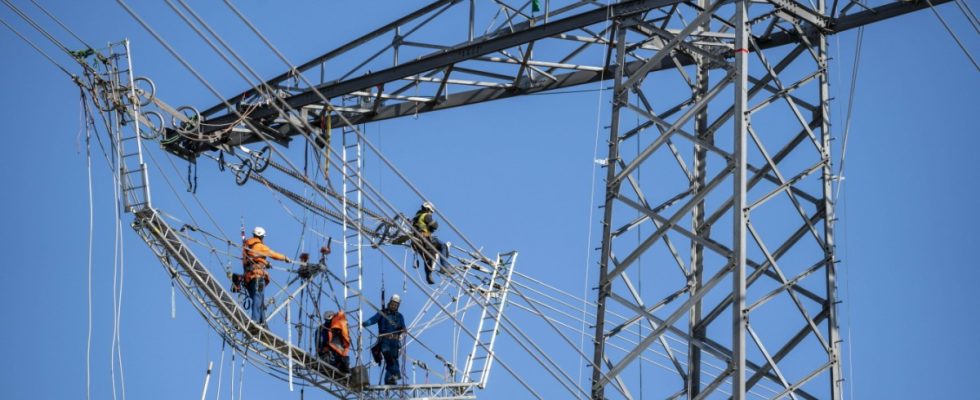No matter how conflicting the opinions on the planned wind farm in the state forest between Altötting and Burghausen may be, both sides agree on one thing: neither the 40 wind turbines desired by the state government and the economy would have been enough to supply the industry in the Bavarian chemical triangle with electricity The 30 systems that are still left after Mehring’s referendum will do the same. The wind turbines could only produce a tenth of the current electricity requirement, which is why in the eyes of some they are not worth it anyway, while in the opinion of others the region should generate at least a small part of the necessary green electricity itself. The majority has to come from outside anyway. The federal government and the network operators Tennet and Bayernwerk are therefore planning two new high-voltage lines that will lead from the north into the Chemical Triangle.
On Wednesday, industry representatives and network operators in Altötting, Upper Bavaria, informed the region’s politicians about the status of the planning. Accordingly, by 2030, a new 380-kilovolt overhead line will run from Zeilarn in the Lower Bavarian district of Rottal-Inn past Marktl, Burghausen and Mehring to Pirach near Burgkirchen in the south of the chemical triangle. This high-voltage line will then replace a less powerful 220 kV line that runs a little further to the west. In addition to these long-known plans, the network operator Tennet now wants to build another 380 kV route from the Simbach area across the Inn to the large industrial areas near Burghausen. Large new substations are to be built at both ends, each requiring a significant area of 20 to 30 hectares. However, the exact locations have not yet been determined, nor has the exact route of the overhead line.
Nevertheless, according to Tennet, the additional, approximately 15 kilometer long route into the chemical triangle should go into operation by 2035 at the latest. Under the abbreviation P474, it is already part of the nationwide network development plan, which the Federal Network Agency formally confirmed on March 1st and which also contains five new higher-level direct current lines that are intended to transport large amounts of wind power from the north to the south of the republic. Industry representatives from the chemical triangle have been calling for another 380 kV line for several years, including directly to parliamentarians and the federal government in Berlin a year ago. The expansion of the power grid must be done “as quickly as possible and without delays,” demanded the spokesman for the Chem-Delta Bavaria interest group, Bernhard Langhammer, on Wednesday.
The hunger for energy from companies like Wacker Chemie and OMV in Burghausen or the companies in the Gendorf chemical park near Burgkirchen is already enormous. The companies in the chemical triangle need around five terawatt hours of electricity per year, which corresponds to around one percent of the electricity requirements in Germany as a whole. This is how Chem-Delta spokesman Langhammer calculates it at every opportunity and also pointed out on Wednesday that this electricity requirement will “almost triple in the next few years”. Because companies want and have to replace fossil fuels with electricity generated from renewable sources if they want to even begin to achieve their own and the state’s climate goals. According to Langhammer, the hot steam that is essential for certain production processes will no longer be generated with gas power plants, but with electricity-powered heat pumps.
At the same time, many chemical companies will have to replace the petroleum that has been flowing through the transalpine TAL pipeline from the Italian Adriatic port of Trieste to Bavaria since the late 1960s not only as an energy source, but also as a raw material for their products. The industry has great hopes for hydrogen and is also calling for new infrastructure in the form of pipelines. If the hydrogen should or must be produced to a large extent by electrolysis on site, this would probably increase the current demand in the chemical triangle almost tenfold in the long term.
For the chemical industry in the region, the new line is of much greater importance than so many wind turbines in the state forest. According to the mayor of Burgkirchen, Johann Krichenbauer (FW), the fact that a power supply is not secured has recently prevented two companies from other sectors from setting up there, with a total of more than 200 jobs. The network operators could not have guaranteed enough electricity for a large data center – and for the operator of large battery storage there was simply nothing to store.
According to Thomas Erhardt-Unglaub, who is responsible for network expansion in the southeast, Tennet wants to invest a sum in the three-digit million range in the overall project. According to managing director Robert Pflügl, the operator Bayernwerk Netz is also investing a three-digit million sum in its subordinate substations and its 110-kilovolt high-voltage lines, which further distribute the electricity from the Tennet routes. Bayernwerk Netz will largely get by with renovations and modernizations.
There has already been some discussion in the region about the first 380 kV line – initially about the necessity and ultimately about the exact route. The Altöttinger district administrator Erwin Schneider (CSU), who sees his district as “almost in the center of the electricity policy hurricane”, must now expect something similar for the next route.

